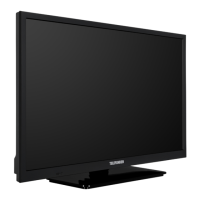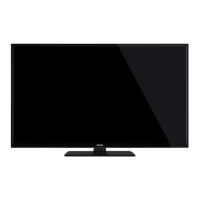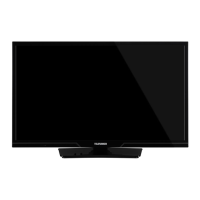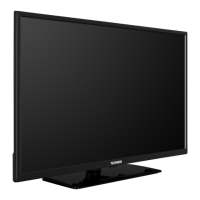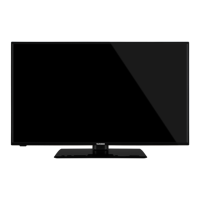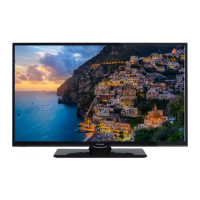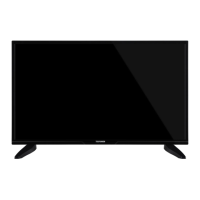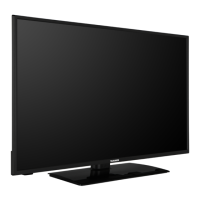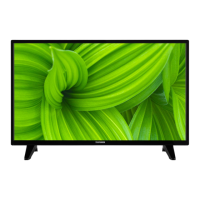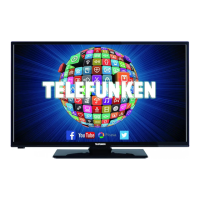Do you have a question about the Telefunken TE24550B42V2E and is the answer not in the manual?
Important warnings regarding electrical safety, placement, and usage.
Guidelines for battery handling, heat exposure, and proper disposal.
Explains symbols for electrical safety, laser, and hazardous terminals.
Tips to prevent TV from falling, especially around children.
Instructions for safely mounting the TV on a wall.
Settings to reduce power consumption, like backlight and screen off.
Teletext, AVL, HbbTV, media sharing, HDR/HLG picture enhancement.
Automatic power down, sleep timer, and standby notifications.
Remote, batteries, instruction book, and quick start guide.
How the TV enters standby due to inactivity or no signal.
Using remote buttons for menu navigation and switching input sources.
Using remote buttons to change channels and adjust volume.
Using the standby button for TV reset and standby modes.
Accessing and customizing the main home screen options.
Searching for channels, menus, applications, and web content.
Accessing Guide, Channels list, and Timers.
Managing installed apps, market access, and resets.
Accessing accessibility features and managing privacy preferences.
Managing input sources and connecting the power cord.
Connecting aerials and understanding license notifications.
Instructions for opening the compartment and inserting batteries.
EU regulations on proper disposal of electronic equipment and batteries.
Technical specifications for wireless LAN frequency ranges and power output.
Regulations on wireless LAN usage in various countries.
Detailed explanation of each button's function on the remote control.
Specific actions for buttons like Standby and My Button 1.
Connecting VGA, YPbPr, AV, HDMI, and audio devices.
Connecting USB, CI modules, and Ethernet cables.
Procedures for switching the TV on and entering standby mode.
Guided setup for language, country, network, and broadcast tuning.
Configuring network connections and selecting picture modes during initial setup.
Using the Media Browser to play files from USB devices.
Streaming content to mobile and controlling CEC devices.
Managing audio output via ARC and accessing the electronic manual.
Adjusting mode, contrast, brightness, sharpness, and colour.
Fine-tuning dynamic contrast, colour temp, noise reduction, and more.
Managing sound output, surround sound, AVL, and audio enhancement.
Gamut mapping, HDMI full range for color and black level adjustments.
Restoring picture settings to factory defaults.
Adjusting equalizer, dynamic bass, and digital audio output settings.
Managing headphone volume, balance, and resetting sound settings.
Setting up wired or wireless network, WPS, and speed tests.
Enabling or disabling standby mode network search.
Scanning for aerial, cable, analogue, and satellite channels.
Managing satellite configuration and network channel scans.
Optional settings like standby search and first-time reset.
Managing conditional access, language settings, and parental controls.
Adjusting date/time, managing sources, and enabling accessibility features.
Magnifying the screen and controlling the minimap display.
Enabling click sound and highlighting program guide events.
Managing Netflix, CEC, and configuring Alexa assistant features.
Enabling and configuring Google Assistant support for voice control.
Adjusting menu timeout, standby LED, and checking software versions.
Configuring auto power down, subtitle display, and store mode.
Enabling audio video sharing and entering Biss keys.
Editing, filtering, and managing the channel list and favorite lists.
Setting PIN, menu lock, maturity lock, and internet lock.
Accessing, browsing, and filtering program schedules by genre or criteria.
Switching EPG views and accessing event details or timers.
Accessing teletext pages and using mix mode.
Searching and performing software upgrades via user interface or automatic scan.
Resolving issues related to poor picture quality, distortion, no picture, or no sound.
Addressing remote control non-operation and no signal from input sources.
Centering and manually adjusting the image position for VGA input.
Illustrates typical display modes and resolutions for PC input.
Lists supported signals for Back AV, YPbPr, and HDMI inputs.
Supported video file extensions, codecs, and resolution/bit rates.
Supported image file extensions and specifications.
Supported audio file extensions and formats.
Supported external and internal subtitle file formats.
Shows resolutions supported via DVI to HDMI connection.
Connecting the TV to a wired network via Ethernet cable.
Connecting the TV to a wireless network via Wi-Fi.
Setting the network type for wired connection.
Scanning, connecting via Wi-Fi, and using WPS for router pairing.
Testing internet speed and configuring advanced network settings.
Connecting mobile devices via WLAN for content sharing.
Enabling TV wake-up via network messages.
Using mobile devices to stream content to the TV.
Pairing remote controllers, audio devices using specific options.
Resolving problems related to wireless network availability and connectivity.
Requirements for AVS, enabling the feature, and playing shared files.
Launching, managing, and adding apps from the market.
Using the browser, Speed Dial, history, tabs, and bookmarks.
Customizing the Speed Dial list for quick website access.
Understanding and using HbbTV for interactive TV services.
How HbbTV applications behave when changing channels.
Using the Smart Center app for streaming, remote control, and initial setup.
Accessing channel lists, EPG, and settings via the app.
Managing channel lists and accessing program details through the app.
Using the app for electronic program guide and application settings.
Streaming content to mobile and mirroring TV sources.
Sharing media files and using mobile as a remote control.
Using voice commands and virtual keyboard via mobile app.
Required TV, network, and mobile device specifications for Smart Center.
Configuring Alexa Built-in and Works With Alexa for voice control.
Enabling and configuring Google Assistant support for voice control.
Example voice commands for controlling the TV with Alexa and Google Assistant.
Feature for automatic battery reordering via Alexa.
Information on DVB receiver suitability and potential future compatibility.
EU directives on waste electrical equipment and battery disposal.
Information about the companies involved in manufacturing and distribution.
Dimensions for hole patterns and required screw sizes for mounting.
Details on screw length (X) and thread (Y) for VESA mounts.
VESA mount measurements presented in various languages.
Important warnings regarding electrical safety, placement, and usage.
Guidelines for battery handling, heat exposure, and proper disposal.
Explains symbols for electrical safety, laser, and hazardous terminals.
Tips to prevent TV from falling, especially around children.
Instructions for safely mounting the TV on a wall.
Settings to reduce power consumption, like backlight and screen off.
Teletext, AVL, HbbTV, media sharing, HDR/HLG picture enhancement.
Automatic power down, sleep timer, and standby notifications.
Remote, batteries, instruction book, and quick start guide.
How the TV enters standby due to inactivity or no signal.
Using remote buttons for menu navigation and switching input sources.
Using remote buttons to change channels and adjust volume.
Using the standby button for TV reset and standby modes.
Accessing and customizing the main home screen options.
Searching for channels, menus, applications, and web content.
Accessing Guide, Channels list, and Timers.
Managing installed apps, market access, and resets.
Accessing accessibility features and managing privacy preferences.
Managing input sources and connecting the power cord.
Connecting aerials and understanding license notifications.
Instructions for opening the compartment and inserting batteries.
EU regulations on proper disposal of electronic equipment and batteries.
Technical specifications for wireless LAN frequency ranges and power output.
Regulations on wireless LAN usage in various countries.
Detailed explanation of each button's function on the remote control.
Specific actions for buttons like Standby and My Button 1.
Connecting VGA, YPbPr, AV, HDMI, and audio devices.
Connecting USB, CI modules, and Ethernet cables.
Procedures for switching the TV on and entering standby mode.
Guided setup for language, country, network, and broadcast tuning.
Configuring network connections and selecting picture modes during initial setup.
Using the Media Browser to play files from USB devices.
Streaming content to mobile and controlling CEC devices.
Managing audio output via ARC and accessing the electronic manual.
Adjusting mode, contrast, brightness, sharpness, and colour.
Fine-tuning dynamic contrast, colour temp, noise reduction, and more.
Managing sound output, surround sound, AVL, and audio enhancement.
Gamut mapping, HDMI full range for color and black level adjustments.
Restoring picture settings to factory defaults.
Adjusting equalizer, dynamic bass, and digital audio output settings.
Managing headphone volume, balance, and resetting sound settings.
Setting up wired or wireless network, WPS, and speed tests.
Enabling or disabling standby mode network search.
Scanning for aerial, cable, analogue, and satellite channels.
Managing satellite configuration and network channel scans.
Optional settings like standby search and first-time reset.
Managing conditional access, language settings, and parental controls.
Adjusting date/time, managing sources, and enabling accessibility features.
Magnifying the screen and controlling the minimap display.
Enabling click sound and highlighting program guide events.
Managing Netflix, CEC, and configuring Alexa assistant features.
Enabling and configuring Google Assistant support for voice control.
Adjusting menu timeout, standby LED, and checking software versions.
Configuring auto power down, subtitle display, and store mode.
Enabling audio video sharing and entering Biss keys.
Editing, filtering, and managing the channel list and favorite lists.
Setting PIN, menu lock, maturity lock, and internet lock.
Accessing, browsing, and filtering program schedules by genre or criteria.
Switching EPG views and accessing event details or timers.
Accessing teletext pages and using mix mode.
Searching and performing software upgrades via user interface or automatic scan.
Resolving issues related to poor picture quality, distortion, no picture, or no sound.
Addressing remote control non-operation and no signal from input sources.
Centering and manually adjusting the image position for VGA input.
Illustrates typical display modes and resolutions for PC input.
Lists supported signals for Back AV, YPbPr, and HDMI inputs.
Supported video file extensions, codecs, and resolution/bit rates.
Supported image file extensions and specifications.
Supported audio file extensions and formats.
Supported external and internal subtitle file formats.
Shows resolutions supported via DVI to HDMI connection.
Connecting the TV to a wired network via Ethernet cable.
Connecting the TV to a wireless network via Wi-Fi.
Setting the network type for wired connection.
Scanning, connecting via Wi-Fi, and using WPS for router pairing.
Testing internet speed and configuring advanced network settings.
Connecting mobile devices via WLAN for content sharing.
Enabling TV wake-up via network messages.
Using mobile devices to stream content to the TV.
Pairing remote controllers, audio devices using specific options.
Resolving problems related to wireless network availability and connectivity.
Requirements for AVS, enabling the feature, and playing shared files.
Launching, managing, and adding apps from the market.
Using the browser, Speed Dial, history, tabs, and bookmarks.
Customizing the Speed Dial list for quick website access.
Understanding and using HbbTV for interactive TV services.
How HbbTV applications behave when changing channels.
Using the Smart Center app for streaming, remote control, and initial setup.
Accessing channel lists, EPG, and settings via the app.
Managing channel lists and accessing program details through the app.
Using the app for electronic program guide and application settings.
Streaming content to mobile and mirroring TV sources.
Sharing media files and using mobile as a remote control.
Using voice commands and virtual keyboard via mobile app.
Required TV, network, and mobile device specifications for Smart Center.
Configuring Alexa Built-in and Works With Alexa for voice control.
Enabling and configuring Google Assistant support for voice control.
Example voice commands for controlling the TV with Alexa and Google Assistant.
Feature for automatic battery reordering via Alexa.
Information on DVB receiver suitability and potential future compatibility.
EU directives on waste electrical equipment and battery disposal.
Information about the companies involved in manufacturing and distribution.
Dimensions for hole patterns and required screw sizes for mounting.
Details on screw length (X) and thread (Y) for VESA mounts.
VESA mount measurements presented in various languages.
| Comb filter | 3D |
|---|---|
| Screen shape | Flat |
| Response time | 6.5 ms |
| Display diagonal | 24 \ |
| Display brightness | 220 cd/m² |
| Display resolution | 1366 x 768 pixels |
| Display technology | LED |
| Native aspect ratio | 16:9 |
| LED backlighting type | Edge-LED |
| Contrast ratio (typical) | 3000:1 |
| Display diagonal (metric) | 60 cm |
| Supported graphics resolutions | 1366 x 768 |
| Motion interpolation technology | - |
| Parental control | Yes |
| Teletext standards | Fast-text |
| Video formats supported | H.265, HEVC, MPEG4 |
| USB 2.0 ports quantity | USB 2.0 ports have a data transmission speed of 480 Mbps, and are backwards compatible with USB 1.1 ports. You can connect all kinds of peripheral devices to them. |
| USB 3.2 Gen 1 (3.1 Gen 1) Type-A ports quantity | 0 |
| Tuner type | Analog & digital |
| Channels quantity | 1000 channels |
| Digital signal format system | DVB-C, DVB-S2, DVB-T2 |
| RMS rated power | 5 W |
| Audio output channels | 2.0 channels |
| Power consumption (typical) | - W |
| Wi-Fi | No |
| Stand type | Center stand |
| Product color | Black |
| Package type | Box |
| Package depth | 110 mm |
| Package width | 625 mm |
| Package height | 460 mm |
| Depth (with stand) | 135 mm |
|---|---|
| Width (with stand) | 553 mm |
| Height (with stand) | 365 mm |
| Depth (without stand) | 63 mm |
| Height (without stand) | 334 mm |
